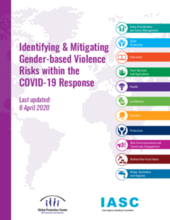The COVID-19 pandemic continues to present an array of challenges, forcing nearly all types of basic service delivery – including, but not limited to, humanitarian response – to drastically adapt. Given how quickly the outbreak continues to evolve; the variation across contexts in the impact of the disease and the measures being implemented to control its spread; and the lack of documented good practice for delivering aid and services under such conditions, to a large extent the entire international system is learning as we go.
As such, this document presents an initial summary of potential GBV risk mitigation actions, based on established good practice, that are starting points to address GBV risks in this unprecedented situation. The GBV risk mitigation actions summarized below are presented in the spirit of collective and iterative problem-solving.
This document is intended to support non-GBV specialist humanitarian actors to identify COVID-19, GBV-specific risks in their sectors, and take actions to mitigate those risks.
This document does not claim to be an exhaustive set of guidance, nor should the content be treated as static. Instead, it contains an initial summary of potential options for adapting established good practice to this unprecedented situation. It will be treated as a working document that will be further refined as the situation and the response continues to evolve.
In addition, we want to work together to try to better understand and document what is working or showing promise in addressing GBV-related risks. So, please feel free to contact Erin Patrick gbvguidelines@gmail.com and/or Christine Heckman checkman@unicef.org with questions, if you need help thinking through any of the recommendations below, or if you have good practice to share.

